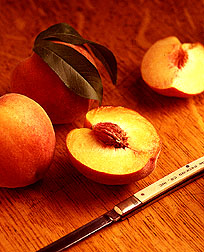This page has been archived and is being provided for reference purposes only. The page is no longer being updated, and therefore, links on the page may be invalid.
Peach and Nectarine Trees: Picking the Perfect Height
By Marcia WoodAugust 19, 2005
Orchardists may soon be able to produce favorite peach varieties--or best-selling nectarines--using new rootstocks that result in shorter, easier-to-manage trees. Agricultural Research Service (ARS) scientists and cooperators developed the new rootstocks in California.
Anywhere from 10 to 50 percent shorter than their conventional orchard counterparts, these semidwarf trees are faster, easier, safer and more convenient to thin, prune and harvest. And, if planted closer together than their larger counterparts--and thinned carefully--the shorter trees should produce fruit that's as large as that of the taller trees. In addition, the per-acre yield of the peaches or nectarines should be about the same as is harvested from orchards planted with standard-size fruit trees.
ARS research geneticist David W. Ramming at Parlier, Calif., chose the parent trees for the two rootstocks, then singled out their offspring from among many other candidates for outdoor tests. Co-investigator and pomologist Theodore M. DeJong of the University of California-Davis, led additional tests, collaborating with Ramming, R. Scott Johnson of the University of California's Kearney Research and Extension Center at Parlier, and James Doyle, now retired from Kearney. In all, the team put the rootstocks through more than a decade of rigorous tests in research and commercial orchards in California's premier peach-growing regions.
The rootstocks are among the first of their kind to be so thoroughly tested in California, the state that produces more peaches and nectarines than any other.
Rootstocks are the rooted, lower portion of a tree to which the upper, fruit-bearing portion, or scionwood, is grafted.
The team received patents last fall for the rootstocks, known as P30-135 and K146-43. They describe their research in a recent issue of California Agriculture magazine.
Peaches and nectarines provide vitamin C, vitamin A, potassium and fiber, and are free of fat and sodium.
ARS is the U.S. Department of Agriculture's chief in-house scientific research agency.

